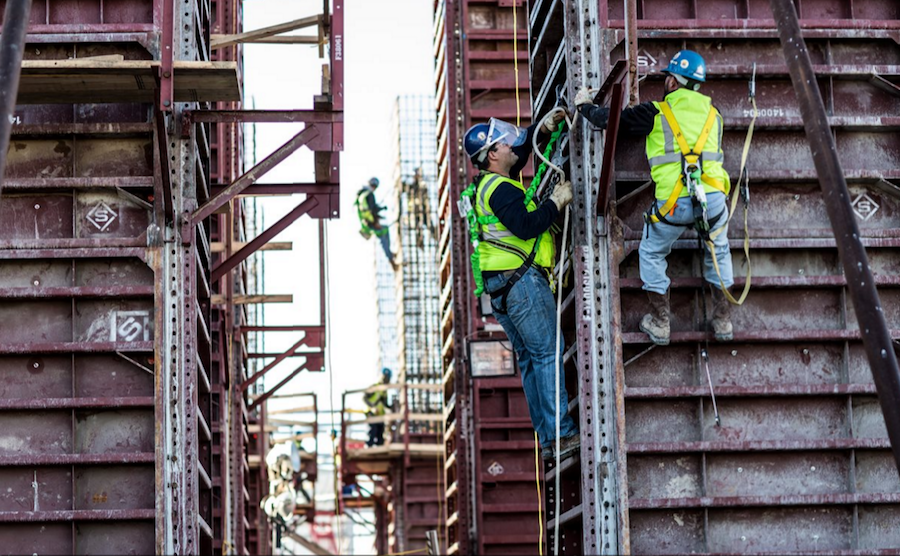Construction Risk Management
Chicago Bridge & Iron's Latest Setback: A $558M Charge

A liquified natural gas project in Louisiana where Chicago Bridge & Iron has a substantial contract. Courtesy: CB&I
Unexpected losses have drastically cut the earnings of another big power sector contractor. Last week it was Fluor. This week it was Chicago Bridge & Iron, which has been on a financial and legal roller coaster all year. Patrick Mullen, Chicago Bridge & Iron’s new chief executive, is pledging a sweeping revamp in the way the company does business in the wake of a $548-million charge in the second quarter from troubled energy projects.
“We recognize...that it only takes a few contracts to result in the material charges that negatively impact the business...and we are working very hard to eliminate these kinds of situations.”
– CEO Patrick Mullen, Chicago Bridge & Iron
CB&I absorbed a $181-million hit from on a pair of gas-fired power plants it is building in Indiana and Pennsylvania and $367 million from two LNG projects in Louisiana and Texas, said Mullen, the company’s new chief executive, at a conference call for investors.
CB&I reported a net loss of $304.1 million, or $3.02 per diluted share, in the second quarter, on revenue of $1.3 billion. Last year the company reported net income of $115.6 million, or $1.09 per diluted share, on $2.2 billion in revenue, in the second quarter.
In response, the company is revamping how it analyzes and manages risk on projects as well as it how it executes work once construction is under way, said Mullen. He recently took over from Philip Asherman, who retired after a 12-year reign that saw CB&I expand from a specialty tank subcontractor to a global energy infrastructure powerhouse.
CB&I is busy now “resetting our culture," Mullen said. “I assure you that we are taking steps to stop this pattern of recurring charge.”
More immediately, CB&I has suspended payment of cash dividends on its common stock, which should net $28 million to $30 million in savings per year. The company also announcing plans to cut “corporate and operating costs” by $100 million a year and sell its technology business.
One analyst who follows CB&I contends that the sale is part of an effort to raise money to pay down CB&I’s $1.8 billion in debt. Without the sale, CB&I might have been in danger of violating vital credit agreements with lenders, argues John Rhodes on Seeking Alpha.
“In my opinion, this wasn't a move to unlock shareholder value but instead it was likely required due to debt pressures,” Rhodes writes.
Mullen faced skeptical questioning on an Aug. 9 conference call with analysts, one of whom noted pointedly that Mullen had previously run CB&I’s engineering and construction division before taking over as CEO.
“These problem projects were under your watch as you, obviously, ran the E&C business,” noted Jamie Cook, lead construction industry analyst for Credit Suisse Securities. “So how do we get comfort that things are really going to change?”
The disappointing numbers come atop a difficult few years for the industry giant. Based in The Woodlands, Texas, CB&I (NYSE: CBI) has seen its stock price fall recently to the $16 range from $90 a share three years ago as CB&I has struggled with a decline in the energy market and a range of problem projects, from money hemorrhaging nuclear plant construction to problematic gas plant and LNG projects.
The new losses have managed to overshadow a July court win in an ongoing legal battle with Westinghouse, which bought CB&I’s money-losing nuclear projects only to file suit in a bid to get an extra $2 billion for liabilities it contends were due under a "true-up" to the price of the sale.
“We're learning significantly from what we've been through,” Mullen told analysts. “And frankly, although the results we talked about today are not pretty at all, this is something we're going to learn from and position ourselves well as an advantage going forward.”
Chicago Bridge & Iron's Problem Projects
Mullen blamed much lower-than-expected productivity by direct-hire union craft workers for at least some of the $181 million charge it is taking on the gas -fired power plants it is building in Indiana and Pennsylvania.
The projects in question are the IPL Eagle Valley gas-turbine plant in Martinsville, Indiana, and another plant being built for Calpine in York, Penn. CB&I has moved to “maximize replacement of this direct-hire workforce with specialty subcontractors,” which in turn has resulted in a uptick in productivity, Mullen said. Mullen cited “lower than expected labor productivity,” delays caused by the weather and increased costs for craft labor and fabrication as helping drive the even bigger $367 million in losses on the LNG projects, which CB&I is building as part of joint ventures for Cameron LNG in Hackberry, La., and Freeport LNG in Freeport, Texas.
Mullen is also pledging wider, company-wide changes in a bid to prevent and rein in problem projects of the type that have wreaked havoc with CB&I’s bottom line. Mullen said CB&I is bolstering the company’s risk assessment procedures used during the pre-contracting process, developing “deeper benchmarking analytics” and “broader cost sensitivity analysis” aimed at focusing on “key costs or risk-drivers for a specific project.” CB&I is also making changes in how it manages risk once a project is under way. In particular, the company has added “integrated and online data analytics and dashboards” in order to “identify emergent issues and correct any small problems before they become big ones.”
CB&I is also working to boost of the efficiency of “many of our fabrication and EPC work processes, as well as eliminate residual interfaces between our operating groups,” Mullen said.
Taking charges to sweep clean the slate is common when a new CEO takes over. But in this case the charges seemed to be far more than investors could easily tolerate, especially given the company's debt and sensitivity to risk.
“As is typical for CB&I, we are executing hundreds of contracts across our businesses, the vast majority of which are completed successfully at attractive margins,” Mullen told analysts. “We recognize, though, that it only takes a few contracts to result the material charges that negatively impact the business significantly, and we are working very hard to eliminate these kinds of situations.”




